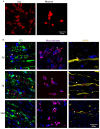Exogenous Mitochondrial Transplantation Facilitates the Recovery of Autologous Nerve Grafting in Repairing Nerve Defects
- PMID: 39471108
- PMCID: PMC11528789
- DOI: 10.1177/09636897241291278
Exogenous Mitochondrial Transplantation Facilitates the Recovery of Autologous Nerve Grafting in Repairing Nerve Defects
Abstract
Autologous nerve transplantation (ANT) remains the gold standard for treating nerve defects. However, its efficacy in nerve repair still requires improvement. Mitochondrial dysfunction resulting from nerve injury may be a significant factor limiting nerve function restoration. This study investigated the impact of supplementing exogenous mitochondria (EM) in ANT and explored its effect on the efficacy of ANT in nerve repair. SD rats were used to prepare a model of a 10 mm sciatic nerve defect repaired by ANT (Auto group) and a model of ANT supplemented with EM (Mito group). At 12 weeks post-operation, functional, neurophysiological, and histological evaluations of the target organ revealed that the Mito group exhibited significantly better outcomes compared with the Auto group, with statistically significant differences (P < 0.05). In vitro experiments demonstrated that EM could be endocytosed by Schwann cells (SCs) and dorsal root ganglion neurons (DRGs) when co-cultured. After endocytosis by SCs, immunofluorescence staining of autophagy marker LC3II and mitochondrial marker Tomm20, as well as adenoviral fluorescence labeling of lysosomes and mitochondria, revealed that EM could promote autophagy in SCs. CCK8 and EDU assays also indicated that EM significantly promoted SCs proliferation and viability. After endocytosis by DRGs, EM could accelerate axonal growth rate. A sciatic nerve defect repair model prepared using Thy1-YFP-16 mice also revealed that EM could accelerate axonal growth in vivo, with statistically significant results (P < 0.05). This study suggests that EM enhances autophagy in SCs, promotes SCs proliferation and viability, and increases the axonal growth rate, thereby improving the efficacy of ANT. This research provides a novel therapeutic strategy for enhancing the efficacy of ANT in nerve repair.
Keywords: Schwann cells; autologous nerve transplantation; functional recovery; mitochondria transplantation; nerve defect.
Conflict of interest statement
Declaration of Conflicting InterestsThe author(s) declared no potential conflicts of interest with respect to the research, authorship, and/or publication of this article.
Figures








Similar articles
-
Transplantation of Schwann cells in a collagen tube for the repair of large, segmental peripheral nerve defects in rats.J Neurosurg. 2013 Sep;119(3):720-32. doi: 10.3171/2013.4.JNS121189. Epub 2013 Jun 7. J Neurosurg. 2013. PMID: 23746104 Clinical Trial.
-
KLF7-transfected Schwann cell graft transplantation promotes sciatic nerve regeneration.Neuroscience. 2017 Jan 6;340:319-332. doi: 10.1016/j.neuroscience.2016.10.069. Epub 2016 Nov 5. Neuroscience. 2017. PMID: 27826105
-
Recellularized nerve allografts with differentiated mesenchymal stem cells promote peripheral nerve regeneration.Neurosci Lett. 2012 Apr 11;514(1):96-101. doi: 10.1016/j.neulet.2012.02.066. Epub 2012 Mar 3. Neurosci Lett. 2012. PMID: 22405891
-
Limited regeneration in long acellular nerve allografts is associated with increased Schwann cell senescence.Exp Neurol. 2013 Sep;247:165-77. doi: 10.1016/j.expneurol.2013.04.011. Epub 2013 May 3. Exp Neurol. 2013. PMID: 23644284 Free PMC article.
-
Transplantation of autologous Schwann cells for the repair of segmental peripheral nerve defects.Neurosurg Focus. 2009 Feb;26(2):E4. doi: 10.3171/FOC.2009.26.2.E4. Neurosurg Focus. 2009. PMID: 19435444 Review.
Cited by
-
Precision Recovery After Spinal Cord Injury: Integrating CRISPR Technologies, AI-Driven Therapeutics, Single-Cell Omics, and System Neuroregeneration.Int J Mol Sci. 2025 Jul 20;26(14):6966. doi: 10.3390/ijms26146966. Int J Mol Sci. 2025. PMID: 40725213 Free PMC article. Review.
References
-
- Liu X, Zou D, Hu Y, He Y, Lu J. Research progress of low-intensity pulsed ultrasound in the repair of peripheral nerve injury. Tissue Eng Part B Rev. 2023;29(4):414–28. - PubMed
MeSH terms
LinkOut - more resources
Full Text Sources
Miscellaneous

